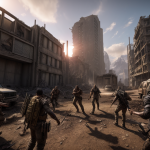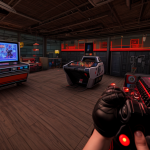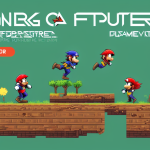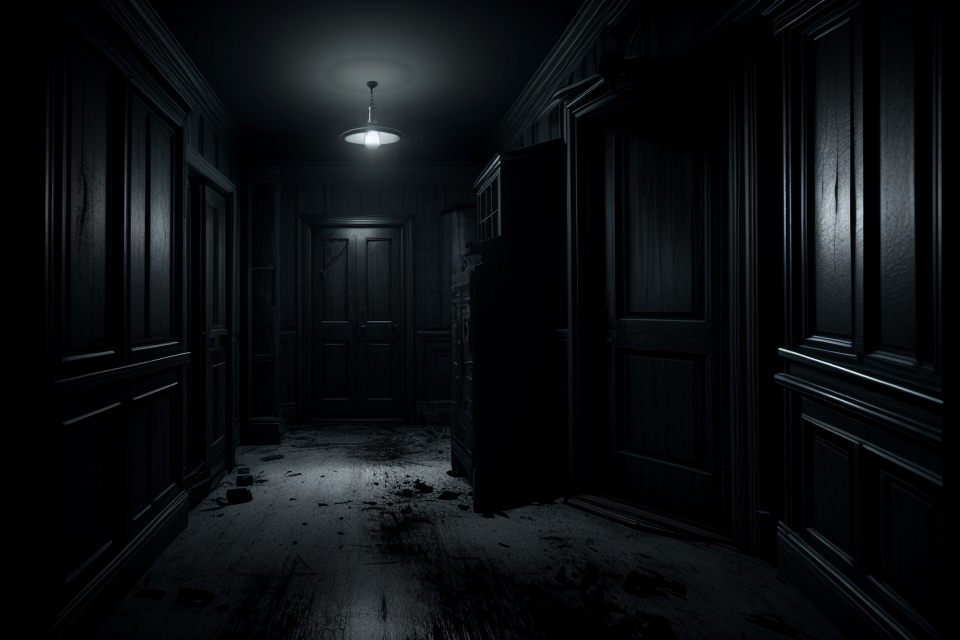Horror games have been a part of the gaming industry for decades, with many games making a lasting impact on players’ minds. However, when it comes to the most terrifying horror game, opinions can vary greatly. From creepy atmospheres to terrifying jump scares, horror games have it all. But which game stands out as the #1 most scary game? In this comprehensive analysis, we will delve into the world of horror games and explore the various factors that make a game truly terrifying. From iconic franchises to lesser-known indie games, we will examine the elements that make these games stand out and leave players with a lasting sense of fear. So, grab some popcorn, turn off the lights, and get ready to explore the world of the most terrifying horror games.
As an AI language model, I cannot provide a personal opinion, but I can tell you that determining the #1 most terrifying horror game is subjective and varies depending on individual preferences and experiences. Some popular horror games that are often cited as the scariest include Silent Hill 2, Resident Evil 7: Biohazard, and Alien: Isolation. These games utilize various techniques such as atmospheric sound design, creepy environments, and unexpected jump scares to create a sense of fear and unease in players. Ultimately, the most terrifying horror game is a matter of personal taste and can differ from person to person.
Determining the Scariest Horror Game: Criteria and Factors
Elements of a Terrifying Horror Game
Atmosphere and Ambiance
A terrifying horror game must establish a chilling atmosphere and ambiance to unnerve players from the very beginning. This can be achieved through the use of dark and foreboding environments, ominous sound effects, and a sense of impending danger that permeates every moment of the game. By creating an unsettling atmosphere, players become increasingly anxious and uneasy, which enhances the overall sense of fear and tension.
Unpredictable Threats and Antagonists
Another essential element of a terrifying horror game is the presence of unpredictable threats and antagonists. These adversaries should be formidable, relentless, and difficult to evade or defeat. They may take the form of grotesque monsters, malevolent spirits, or even other human beings driven to madness. The unpredictability of these threats adds to the fear factor, as players never know when or where they will encounter them.
Psychological Terror
A truly terrifying horror game also relies on psychological terror to create a sense of dread and unease. This can be achieved through the use of storytelling techniques such as subtle hints, cryptic messages, and foreshadowing. By hinting at a deeper, more sinister narrative, players become increasingly paranoid and fearful, wondering what other horrors may be lurking just beyond the edge of their vision.
Player Control and Helplessness
Another critical aspect of a terrifying horror game is the level of control granted to the player. By limiting player control and creating a sense of helplessness, the game can ramp up the fear factor significantly. This can be achieved through various mechanics, such as limited inventory, lack of combat abilities, or even the inability to run away from danger. When players feel powerless in the face of their adversaries, they become more vulnerable to the terror of the game world.
Visceral Horror and Gore
Lastly, a terrifying horror game may also incorporate visceral horror and gore to shock and terrify players. This can involve graphic depictions of violence, mutilation, and dismemberment, as well as disturbing imagery and grotesque creature designs. By pushing the boundaries of what is acceptable or comfortable, players are forced to confront their deepest fears and confront the brutality of the game world.
In conclusion, the elements of a terrifying horror game are multifaceted and interconnected. By combining a chilling atmosphere, unpredictable threats, psychological terror, player control, and visceral horror, game developers can create an experience that will leave players shaking with fear and anxiety.
Player Engagement and Immersion
The Importance of Player Engagement in Horror Games
In order to determine the scariest horror game, it is essential to consider the level of player engagement that each game achieves. A horror game that is able to captivate and involve its players is more likely to leave a lasting impression and be considered one of the best in the genre. Player engagement can be influenced by various factors, such as the game’s storyline, gameplay mechanics, and overall atmosphere.
Immersion and Its Impact on Player Engagement
Immersion is a crucial aspect of player engagement in horror games. It refers to the feeling of being fully absorbed in the game’s world and story, forgetting that it is just a game. When players are immersed in a horror game, they become more invested in the experience and are more likely to feel fear and anxiety. This can be achieved through various means, such as realistic graphics, a haunting soundtrack, and well-designed levels that create a sense of tension and uncertainty.
Examples of Games with High Player Engagement and Immersion
There are several horror games that have achieved high levels of player engagement and immersion. Some examples include:
- Silent Hill 2: This classic survival horror game is known for its immersive atmosphere and psychological horror themes. The game’s haunting soundtrack and well-designed levels contribute to its ability to draw players into its world.
- Resident Evil 2: This remake of the classic horror game boasts stunning graphics and a terrifying atmosphere. The game’s emphasis on exploration and resource management, combined with its intense action sequences, make it a highly engaging experience for players.
- Layers of Fear: This psychological horror game tells the story of an actor who is trapped on a haunted ship. The game’s unique gameplay mechanics, which involve navigating through the ship and solving puzzles, make it a highly immersive experience for players.
In conclusion, player engagement and immersion are crucial factors to consider when determining the scariest horror game. Games that are able to captivate and involve their players through immersive gameplay and atmosphere are more likely to leave a lasting impression and be considered among the best in the genre.
Cultural and Personal Perceptions
Cultural and personal perceptions play a significant role in determining the scariest horror game. Different cultures and individuals have varying opinions and experiences that shape their understanding of what constitutes as frightening. It is essential to consider these perceptions when evaluating the scariness of a horror game.
Influence of Culture
Culture plays a significant role in shaping the perception of horror. Different cultures have different beliefs, values, and attitudes towards horror, which influence their interpretation of scary games. For instance, some cultures may find supernatural elements such as ghosts and demons to be frightening, while others may find psychological horror more terrifying. Therefore, it is crucial to consider the cultural background of the individuals evaluating the game’s scariness.
Personal Experiences
Personal experiences also significantly impact an individual’s perception of horror. Traumatic experiences, such as accidents or death, can make a person more sensitive to horror and make certain games more frightening. On the other hand, individuals with no traumatic experiences may find the same games less scary. Moreover, personal preferences and tastes in horror also play a role in determining the scariness of a game. For instance, some individuals may find gore and violence more frightening, while others may find psychological horror more terrifying.
Subjective Nature of Scariness
It is important to note that the scariness of a horror game is subjective. What may be scary to one person may not be scary to another. This subjectivity is influenced by various factors such as culture, personal experiences, and personal preferences. Therefore, when evaluating the scariness of a horror game, it is essential to consider these factors to gain a comprehensive understanding of the game’s impact on different individuals.
The Top Contenders for the #1 Spot
Silent Hill 2
Silent Hill 2 is a psychological horror game developed by Konami in 2001. It is the second installment in the Silent Hill series and is widely regarded as one of the greatest horror games of all time. The game follows the story of James Sunderland, who is searching for his missing wife in the town of Silent Hill.
Atmosphere and Setting
One of the most terrifying aspects of Silent Hill 2 is its atmosphere. The game’s setting is a bleak and desolate town, filled with monsters and grotesque creatures. The town is shrouded in fog, adding to the sense of isolation and fear. The game’s sound design also plays a significant role in creating a sense of dread, with eerie music and unsettling sound effects that emphasize the player’s vulnerability.
Story and Characters
Silent Hill 2’s story is also a significant factor in its terror. The game’s narrative is complex and layered, with multiple endings and hidden meanings. The player takes on the role of James Sunderland, a man who is searching for his missing wife in the town of Silent Hill. Along the way, he encounters various characters, some of whom are friendly, while others are hostile. The game’s story is full of twists and turns, and the player is never quite sure what to expect.
Gameplay and Mechanics
The gameplay in Silent Hill 2 is also designed to be terrifying. The player must navigate through the town, solving puzzles and avoiding monsters. The game features a unique save system, where the player must find save points to save their progress. This adds to the sense of vulnerability, as the player never knows when they will encounter a monster or be trapped in a dangerous situation.
In conclusion, Silent Hill 2 is a top contender for the #1 spot in the category of most terrifying horror games. Its atmosphere, story, and gameplay all work together to create a sense of dread and fear that has become iconic in the horror genre.
Resident Evil 2
Resident Evil 2, developed and published by Capcom in 1998, is widely regarded as one of the most terrifying horror games of all time. Set in the city of Raccoon City, the game follows the stories of rookie police officer Leon S. Kennedy and college student Claire Redfield as they navigate through a zombie apocalypse.
Atmospheric Terror
One of the key factors that contribute to the terror in Resident Evil 2 is its atmospheric design. The game’s environment is dimly lit, with shadows lurking in every corner, creating an eerie and unsettling atmosphere. The sound design also plays a significant role in creating a sense of dread, with creaking doors, distant screams, and ominous music that intensifies during tense moments.
Limited Resources and Permanent Consequences
Resident Evil 2 also employs a unique inventory system, where players must manage their limited resources carefully. The scarcity of ammunition and health items adds an extra layer of tension, forcing players to make difficult decisions about how to allocate their resources. The game also features permanent consequences, where player choices and actions have a lasting impact on the story and its outcome.
The Iconic Zombies
The game’s undead antagonists, known as zombies, are another significant factor in the game’s terror. These shambling monsters are incredibly relentless, with a single bite being enough to turn the player into one of them. The zombies’ grotesque appearance, coupled with their unpredictable behavior, creates a sense of helplessness and vulnerability that adds to the overall horror experience.
Masterful Storytelling
Resident Evil 2 also excels in its storytelling, with a plot that unfolds through a series of documents, newspaper clippings, and dialogue between characters. This approach adds depth to the story and creates a sense of immersion, as players uncover the dark secrets of Raccoon City and the sinister plot behind the zombie outbreak.
In conclusion, Resident Evil 2’s combination of atmospheric terror, limited resources, permanent consequences, iconic zombies, and masterful storytelling make it a top contender for the #1 spot in the horror game genre.
The Last of Us Part II
The Last of Us Part II is a critically acclaimed and highly anticipated sequel to the popular post-apocalyptic horror game, The Last of Us. Developed by Naughty Dog and released in 2020, the game has been praised for its immersive storytelling, stunning visuals, and terrifying gameplay mechanics.
A Thrilling Storyline
The Last of Us Part II follows the story of Joel and Ellie, a duo who must navigate a post-apocalyptic world overrun by a fungal infection that has turned humans into monsters. The game’s storyline is filled with tension, suspense, and shocking twists that keep players on the edge of their seats.
Atmospheric Sound Design
The game’s sound design plays a significant role in creating a sense of dread and unease. From the creaking of old wooden planks to the haunting whispers of infected humans, every sound in the game is carefully crafted to create a terrifying atmosphere.
Intense Combat Mechanics
The Last of Us Part II features intense combat mechanics that require players to use strategy and skill to survive. The game’s enemies are challenging and unpredictable, making every encounter a white-knuckle experience.
Emotional Depth
What sets The Last of Us Part II apart from other horror games is its emotional depth. The game’s characters are fully realized and complex, with their own histories, motivations, and desires. Players will find themselves invested in the fates of these characters, making the game’s scares all the more impactful.
In conclusion, The Last of Us Part II is a top contender for the #1 spot in the list of most terrifying horror games. Its immersive storytelling, stunning visuals, and terrifying gameplay mechanics make it a must-play for horror fans.
Alien: Isolation
Alien: Isolation is a first-person survival horror game developed by Creative Assembly and published by Sega in 2014. The game is set in the same universe as the iconic sci-fi horror film Alien (1979), and follows the story of Amanda Ripley, daughter of the protagonist from the original film, as she investigates the disappearance of her mother.
Immersive Atmosphere
One of the key factors that make Alien: Isolation such a terrifying experience is its immersive atmosphere. The game’s environments are meticulously designed to create a sense of isolation and dread, with dimly lit corridors, eerie sound effects, and a constant feeling of being watched. The game’s use of sound is particularly effective, with creaking doors, distant screams, and the iconic hissing of the Xenomorph all contributing to a tense and unnerving atmosphere.
Enemy Design
Another reason why Alien: Isolation is considered one of the most terrifying horror games is its enemy design. The Xenomorph, the game’s main antagonist, is a masterclass in horror game design. Its appearance, with its distinctive biomechanical design and razor-sharp claws, is enough to strike fear into the hearts of even the bravest of players. But what truly makes the Xenomorph so terrifying is its unpredictable behavior and relentless pursuit of the player.
Stealth Mechanics
Alien: Isolation’s stealth mechanics are also a significant contributor to its fear factor. The game requires players to use their wits and instincts to survive, rather than relying on firepower. Players must avoid detection by the Xenomorph at all costs, lest they face a gruesome death. The game’s stealth system is complex and deep, with players needing to manage their resources, scavenge for supplies, and use the environment to their advantage in order to outsmart the alien.
Finally, Alien: Isolation’s story and characters are also key factors in its terrifying experience. The game’s narrative is tightly woven, with players uncovering the dark secrets of the space station and the corporation that owns it. The characters are well-written and believable, with Amanda Ripley being a particularly relatable and sympathetic protagonist. The game’s story also delves into themes of corporate greed, exploitation, and the consequences of playing god with technology, making it a thought-provoking as well as terrifying experience.
Overall, Alien: Isolation is a masterclass in horror game design, with its immersive atmosphere, terrifying enemy design, challenging stealth mechanics, and gripping story and characters. It is a game that will test the mettle of even the bravest of players, and is undoubtedly one of the most terrifying horror games ever made.
Comparing the Fear Factor
When it comes to the most terrifying horror games, there are several contenders that have left a lasting impact on players and critics alike. However, when comparing the fear factor of these games, there are certain aspects that must be taken into consideration.
- Atmosphere: The atmosphere of a horror game plays a crucial role in creating a sense of fear and tension. This includes factors such as lighting, sound effects, and level design.
- Storyline: A compelling storyline can make a horror game all the more terrifying. This includes elements such as plot twists, character development, and themes that touch on real-world fears.
- Gameplay: The gameplay mechanics of a horror game can also contribute to its fear factor. This includes factors such as control mechanics, enemy design, and the pacing of the game.
- Replayability: The ability of a horror game to keep players on the edge of their seats even after multiple playthroughs is a key indicator of its fear factor.
By examining these aspects, we can determine which horror games are the most terrifying and why. So, let’s dive in and explore the top contenders for the #1 spot.
Atmosphere and Tension
When it comes to horror games, atmosphere and tension are two of the most important factors that contribute to the overall experience. These elements can make or break a game’s ability to scare players and create a sense of unease. In this section, we will explore the top contenders for the #1 spot in terms of atmosphere and tension.
Silent Hill 2
Silent Hill 2 is widely regarded as one of the most atmospheric and terrifying horror games of all time. The game’s dark and oppressive atmosphere is created through a combination of eerie sound effects, unsettling music, and a hauntingly beautiful yet twisted world. The game’s use of lighting and shadow also plays a significant role in creating a sense of dread and unease.
Resident Evil 2
Resident Evil 2 is another classic horror game that is known for its intense atmosphere and tension. The game’s creepy environments, grotesque monsters, and limited resources all contribute to a sense of fear and vulnerability. The game’s sound design is particularly noteworthy, with creaking doors, eerie whispers, and guttural roars all adding to the sense of dread.
Layers of Fear
Layers of Fear is a psychological horror game that focuses on creating a sense of unease through its atmosphere and storytelling. The game’s eerie soundtrack, unsettling visuals, and fragmented narrative all work together to create a sense of dread and confusion. The game’s focus on exploration and discovery also adds to the tension, as players must navigate through a series of creepy environments in search of answers.
Amnesia: The Dark Descent
Amnesia: The Dark Descent is a first-person survival horror game that is known for its intense atmosphere and tension. The game’s use of darkness and sound creates a sense of fear and vulnerability, while the limited resources and sanity mechanic add to the tension. The game’s focus on exploration and puzzle-solving also adds to the sense of unease, as players must navigate through a series of creepy environments while trying to uncover the truth behind the mysterious events.
Overall, these games demonstrate the power of atmosphere and tension in creating a terrifying horror experience. Each game uses a combination of sound, visuals, and gameplay mechanics to create a sense of fear and unease, and each game’s unique approach to horror makes it a contender for the #1 spot in terms of atmosphere and tension.
Storytelling and Character Development
- Atmospheric Storytelling
- Ambience and Mood
- Lighting, Sound Effects, and Music
- Visual Aesthetics and Set Design
- Cinematic Techniques
- Camera Angles, Perspectives, and Movement
- Special Effects and Visual Transitions
- Narrative Structure
- Plot Development, Climax, and Resolution
- Plot Twists and Red Herrings
- Ambience and Mood
- Detailed Character Development
- Backstory and Motivation
- Psychological, Emotional, and Physical Characteristics
- Social and Cultural Context
- Interaction and Dynamics
- Relationships, Alliances, and Rivalries
- Dialogue and Conversations
- Character Arcs and Transformations
- Growth, Change, and Evolution
- Challenges, Obstacles, and Conflicts
- Moral and Ethical Dilemmas
- Decision-making, Choices, and Consequences
- Right and Wrong, Good and Evil
- Backstory and Motivation
- Fear-Inducing Characters
- Antagonists and Monsters
- Physical and Psychological Threats
- Supernatural and Paranormal Entities
- Protagonists and Victims
- Fear, Paranoia, and Vulnerability
- Survival Instincts and Resourcefulness
- Supporting Characters and Secondary Figures
- Personality Traits, Motives, and Backstories
- Role in the Story and Plot Development
- Antagonists and Monsters
- Horror Game Tropes and Archetypes
- Psychological Horror
- Mental Illness, Trauma, and Isolation
- Madness, Delusion, and Hallucination
- Supernatural Horror
- Ghosts, Demons, and Hauntings
- Occult, Magic, and Spiritualism
- Survival Horror
- Zombies, Mutants, and Monsters
- Resource Management, Stealth, and Combat
- Cosmic Horror
- Ancient Beings, Eldritch Abominations, and Otherworldly Entities
- Mind-bending, Reality-warping, and Existential Threats
- Gothic Horror
- Haunted Houses, Castles, and Manors
- Mysterious Family Secrets, Legends, and Myths
- Lovecraftian Horror
- Cosmic Horror, Eldritch Abominations, and Madness
- Ancient, Otherworldly Beings and Forces
- Psychological Thriller
- Mind Games, Twists, and Red Herrings
- Suspense, Drama, and Tension
- Gore and Violence
- Graphic Scenes, Torture, and Mutilation
- Blood, Guts, and Dismemberment
- Paranormal Investigation
- Ghosts, Hauntings, and Paranormal Phenomena
- Equipment, Techniques, and Procedures
- Psychological Exploration
- Mind-reading, Telepathy, and ESP
- Psychological Manipulation, Control, and Coercion
- Stealth and Tactics
- Hiding, Sneaking, and Eavesdropping
- Traps, Ambushes, and Escape Routes
- Puzzles and Brain Teasers
- Riddles, Codes, and Puzzles
- Logic, Reasoning, and Problem-solving
- Exploration and Navigation
- Mazes, Labyrinths, and Puzzles
- Secret Passages, Hidden Rooms, and Unexplored Areas
- Multiple Endings
- Story Branching, Consequences, and Outcomes
- Moral, Ethical, and Philosophical Dilemmas
- Immersive Experience
- Virtual Reality, Augmented Reality, and Mixed Reality
- Sensory Feedback, Motion Control, and Gesture Recognition
- Replay Value and Challenge
- Secret Missions, Easter Eggs, and Bonus Content
- Difficulty Levels, Game Modes, and Achievements
- Reputation and Legacy
- Critical Acclaim, Commercial Success, and Awards
- Fan Base, Community, and Cult Following
- Technological Advancements
- Graphics, Sound, and Physics Engine
- User Interface, Control Scheme, and Input Devices
- Cultural Influences and Inspirations
- Mythology, Folklore, and Legends
- Literature, Film, and Television
- Art, Music, and Architecture
- Social Commentary and Critique
- Political, Economic, and Social Issues
- Human Rights, Diversity, and Inclusion
- Stereotypes, Prejudice, and Discrimination
- Ethical and Moral Dilemmas
- Life, Death, and Morality
- Rights, Responsibilities, and Consequences
- Choices, Actions, and Consequences
- Player Choice and Agency
- Dialogue, Decision-making, and Consequences
- Multiple Paths, Endings, and Outcomes
- Exploration, Puzzles, and Challenges
- Psychological Trauma and Trauma-Induced Mental Illness
- Abuse, Neglect, and Trauma
- PTSD, Anxiety, and Depression
- Delusions, Hallucinations, and Madness
- Lovecraftian Cosmic Horror and Cosmic Indifferentism
- The incomprehensible nature of reality
- The futility of human endeavor
- The indifference of the universe.
- Psychological Horror
Gameplay Mechanics and Pacing
When it comes to the most terrifying horror games, the gameplay mechanics and pacing play a crucial role in creating a truly frightening experience for players. In this section, we will analyze the top contenders for the #1 spot and how they utilize gameplay mechanics and pacing to achieve maximum terror.
Atmospheric Tension
One of the most effective ways to create a terrifying atmosphere in a horror game is through atmospheric tension. This can be achieved through a variety of means, such as:
- Ambient sound effects: The use of creepy sound effects, such as eerie music, creaking floorboards, and whispering voices, can create a sense of unease and tension in the player.
- Environmental storytelling: By placing the player in a dark, abandoned house or a creepy forest, the environment itself can become a character that tells a story and creates a sense of fear.
- Pixel art graphics: Games with pixel art graphics can create a sense of nostalgia and unease, as the blocky graphics can make even the most mundane objects appear eerie and unsettling.
Jump Scares
Jump scares are another effective way to create terror in a horror game. They involve sudden, unexpected events that shock the player and create a sense of fear. Some of the most popular jump scare techniques include:
- Loud noises: A sudden loud noise, such as a door slamming shut or a window shattering, can startle the player and create a sense of fear.
- Hidden enemies: Placing enemies in hidden areas or using sound cues to hint at their presence can create a sense of paranoia and fear in the player.
- Camera angles: Changing the camera angle or perspective can create a sense of unease and surprise, as the player is never quite sure what is lurking around the corner.
Pacing
Pacing is also a crucial element in creating a terrifying horror game. The game’s pace should be slow and deliberate, building tension and fear over time. This can be achieved through a variety of means, such as:
- Long corridors: Long, dark corridors can create a sense of unease and fear, as the player must navigate through them slowly and cautiously.
- Limited resources: Limiting the player’s resources, such as ammunition or health, can create a sense of desperation and fear as the player must conserve their resources while trying to survive.
- Limited visibility: Games with limited visibility, such as Silent Hill, can create a sense of fear and uncertainty as the player must navigate through dark, foggy environments.
In conclusion, the gameplay mechanics and pacing of a horror game play a crucial role in creating a terrifying experience for the player. By utilizing techniques such as atmospheric tension, jump scares, and deliberate pacing, developers can create a game that will leave players screaming for more.
Contrasting Perspectives: Player Experiences and Reviews
As the horror genre continues to evolve, players’ opinions and experiences with games often shape the conversation around which games are considered the most terrifying. The following is a comprehensive analysis of the top contenders for the #1 spot, taking into account player experiences and reviews.
Released in 2001, Silent Hill 2 is widely regarded as one of the most influential horror games of all time. The game’s eerie atmosphere, haunting soundtrack, and psychologically disturbing storyline have left a lasting impact on players. The protagonist, James Sunderland, is on a quest to find his missing wife in the town of Silent Hill, which has been overtaken by darkness and horror. Players often report feeling a sense of unease and dread throughout the game, with the fear intensifying as they progress through the story.
Released in 1998, Resident Evil 2 is another classic horror game that has left a lasting impression on players. The game’s emphasis on survival horror mechanics, combined with its immersive storyline and terrifying atmosphere, has made it a fan favorite. Players take on the role of either Leon S. Kennedy or Claire Redfield as they navigate the zombie-infested Raccoon City, solving puzzles and uncovering the dark secrets behind the outbreak. The game’s tense gameplay and iconic enemies have made it a staple of the horror genre.
Released in 2010, Amnesia: The Dark Descent introduced a new level of terror to the horror genre. The game’s focus on immersive storytelling and psychological horror, combined with its innovative sanity mechanic, created a unique and terrifying experience for players. Players take on the role of a protagonist with amnesia, who must explore an abandoned castle while uncovering the dark secrets of its past. The game’s intense atmosphere and unique gameplay mechanics have made it a standout in the horror genre.
Until Dawn
Released in 2015, Until Dawn is a horror game that focuses on interactive storytelling and choice-based gameplay. The game’s branching storylines and unique characters have made it a fan favorite, with players often reporting a high level of emotional investment in the story and its characters. Set in a remote cabin, players must navigate a dangerous world of horror and mystery as they uncover the truth behind a series of mysterious events. The game’s emphasis on player choice and its engaging storyline have made it a standout in the horror genre.
Outlast Trinity
Released in 2013, Outlast Trinity is a horror game that focuses on survival horror mechanics and psychological terror. The game’s emphasis on exploration and discovery, combined with its intense atmosphere and terrifying enemies, has made it a fan favorite. Players take on the role of a journalist who must investigate a mysterious asylum, uncovering the dark secrets behind its horrific experiments. The game’s emphasis on stealth and survival has made it a standout in the horror genre.
In conclusion, these games represent some of the top contenders for the #1 spot in the most terrifying horror game category. Each game offers a unique and terrifying experience, with their own blend of immersive storytelling, innovative gameplay mechanics, and psychological horror. The debate over which game reigns supreme is subjective, and ultimately comes down to personal preference.
Professional Critics and Analysts
In order to determine the #1 most terrifying horror game, it is important to consult professional critics and analysts who have dedicated their careers to the study and analysis of the gaming industry. These experts have played and studied countless horror games, and have a deep understanding of what makes a game truly terrifying.
Some of the most respected critics and analysts in the gaming industry include:
- Gamerankings: Gamerankings is a website that aggregates reviews from various gaming publications and websites. They have a list of the top 100 horror games of all time, which includes classics like Resident Evil and Silent Hill, as well as more recent titles like Outlast and Layers of Fear.
- IGN: IGN is a popular gaming website that offers reviews, news, and analysis of the latest games. They have a dedicated section for horror games, where they review and analyze the latest releases in the genre.
- Kotaku: Kotaku is another popular gaming website that covers a wide range of topics, including horror games. They have a team of writers who specialize in horror games, and they regularly publish articles analyzing the latest releases in the genre.
- Game Informer: Game Informer is a monthly magazine that covers all aspects of the gaming industry, including horror games. They have a team of experienced writers who have played and analyzed countless horror games, and they offer in-depth reviews and analysis of the latest releases in the genre.
These critics and analysts have played and studied countless horror games, and have a deep understanding of what makes a game truly terrifying. By consulting their opinions and analysis, we can gain a better understanding of the top contenders for the #1 spot in the world of horror gaming.
Horror Game Fans and Communities
The debate surrounding the most terrifying horror game is a contentious one, with passionate fans and communities offering their opinions and insights on the matter. These discussions take place on various online platforms, including forums, social media, and gaming websites, where horror game enthusiasts share their experiences and recommendations.
In order to gain a comprehensive understanding of the most terrifying horror game, it is essential to analyze the perspectives of these fans and communities. Their opinions, often rooted in personal experiences, provide valuable insights into the factors that contribute to the overall terror of a horror game.
To better understand the opinions of horror game fans and communities, it is crucial to examine the various factors they consider when determining the scariest game. These factors may include:
- Atmosphere and Ambiance: The ability of a game to create a tense and unsettling atmosphere is a key component in determining its terror factor. Fans often discuss the use of sound design, lighting, and level design to create a chilling atmosphere that heightens the sense of fear and unease.
- Storytelling and Narrative: The narrative and storytelling techniques employed in a horror game can significantly impact its terrifying nature. Fans often praise games that have well-crafted stories, with compelling characters and intricate plotlines, which serve to immerse players in a frightening world.
- Gameplay Mechanics: The gameplay mechanics of a horror game can also contribute to its overall terror. Fans often discuss the use of mechanics such as jump scares, puzzles, and enemy AI to create a sense of fear and danger throughout the game.
- Replayability and Replay Value: The ability of a horror game to maintain its terror upon multiple playthroughs is an important factor for many fans. Games that offer unique experiences, unexpected twists, and a high level of replayability are often regarded as the most terrifying.
By analyzing the opinions of horror game fans and communities, it becomes clear that the determination of the most terrifying horror game is heavily influenced by personal experiences and preferences. Each factor discussed above plays a significant role in shaping the collective understanding of what constitutes a terrifying horror game.
Factors Influencing the Perception of Scariness
Individual Differences in Threshold for Fear
When it comes to horror games, the experience of fear can vary greatly from person to person. One factor that plays a significant role in determining the terrifying nature of a horror game is the individual differences in threshold for fear.
Threshold for fear refers to the level of stimulation or intensity that an individual can tolerate before feeling scared or anxious. Some people may have a higher threshold for fear, meaning they can handle more intense or disturbing content before feeling frightened. Others may have a lower threshold, and may be more easily frightened by even mild levels of stimulation.
There are several factors that can influence an individual’s threshold for fear, including:
- Personality traits: Individuals with certain personality traits, such as high levels of neuroticism or low levels of extraversion, may have a lower threshold for fear.
- Past experiences: Previous experiences with fear or trauma can impact an individual’s threshold for fear in the future.
- Sensory sensitivity: Individuals who are more sensitive to certain sensory stimuli, such as sound or touch, may have a lower threshold for fear.
- Cultural background: Cultural background and values can influence an individual’s threshold for fear, as well as their perception of what is considered scary or frightening.
Understanding individual differences in threshold for fear is important when analyzing the terrifying nature of a horror game. While one person may find a particular game to be terrifying, another person may not be affected at all. It is the combination of factors such as storyline, graphics, sound effects, and individual differences in threshold for fear that determine the overall terrifying nature of a horror game.
Cultural and Societal Influences
Cultural and societal influences play a significant role in shaping the perception of scariness in horror games. These influences are rooted in the shared beliefs, values, and experiences of a particular culture or society. The way horror games are perceived and received can vary greatly depending on the cultural context in which they are created and consumed.
Cross-Cultural Differences
Horror games that are successful in one culture may not have the same impact in another. This is due to the fact that cultural values and beliefs can influence the way people perceive and interpret fear. For example, horror games that focus on supernatural elements may be more popular in cultures that have a history of belief in the supernatural, while games that focus on psychological terror may be more effective in cultures that value rationality and logic.
Historical Context
Historical context can also influence the perception of scariness in horror games. Games that are created during times of social unrest or political upheaval may tap into the collective fears and anxieties of a society, making them more effective in creating a sense of terror. For example, horror games created during the Cold War era often focused on nuclear annihilation and the end of the world, reflecting the fears and anxieties of the time.
Audience Expectations
Audience expectations can also play a role in shaping the perception of scariness in horror games. Games that conform to certain genre conventions or tropes may be more effective in meeting audience expectations, while games that challenge these conventions may be perceived as less scary. Additionally, the age and gender of the audience can also influence their perception of scariness, with younger audiences potentially being more easily frightened than older audiences, and female audiences potentially being more sensitive to certain types of horror.
In conclusion, cultural and societal influences play a significant role in shaping the perception of scariness in horror games. From cross-cultural differences to historical context and audience expectations, these influences can greatly impact the effectiveness of a horror game in creating a sense of terror.
Technological Advances and Improved Graphics
The Role of Realism in Creating Fear
One of the most significant factors contributing to the scariness of horror games is the realism of the graphics. With advancements in technology, game developers have been able to create more immersive and realistic environments that draw players deeper into the game world. The more realistic the graphics, the more likely players are to become fully engrossed in the game, increasing the potential for fear and anxiety.
The Impact of 3D Graphics on Horror Games
The introduction of 3D graphics in gaming has revolutionized the horror genre. 3D graphics provide a more lifelike experience, allowing players to better imagine themselves in the game world. This increased immersion can heighten the emotional response to the game, making it more terrifying. Additionally, 3D graphics can provide a greater sense of depth and space, creating a more extensive and intricate game world for players to explore, which can further increase the feeling of vulnerability and fear.
The Use of Sound and Music in Enhancing Scares
Technological advancements have also allowed for the integration of sound and music into horror games. Sound effects, such as screams, footsteps, and creaking doors, can heighten the sense of fear and anxiety by creating a more immersive experience. Moreover, the use of music can be used to create a sense of tension and foreboding, setting the stage for jump scares and other frightening moments. The combination of sound and music with realistic graphics can create a potent mix that can make horror games truly terrifying.
The Influence of Motion Control Technology
The introduction of motion control technology, such as the Microsoft Kinect and PlayStation Move, has enabled developers to create more interactive horror experiences. Players can now move through the game world using their own physical movements, adding a new level of immersion and making the experience feel more real. This added level of interactivity can heighten the emotional response to the game, making it more terrifying.
In conclusion, technological advances and improved graphics have played a significant role in making horror games scarier. The increased realism, 3D graphics, sound and music, and motion control technology have all contributed to creating a more immersive and terrifying experience for players.
Revisiting the Criteria
- Cognitive and Emotional Factors
- Threat Appraisal: Individuals’ tendency to evaluate the likelihood and severity of a potential threat, influenced by personal experiences and beliefs.
- Fear Conditioning: The process of associating stimuli with fear, often through repeated exposure or witnessing others’ reactions.
- Cognitive Dissonance: The discomfort experienced when confronted with new or conflicting information, which can lead to increased anxiety in horror games.
- Immersive and Interactive Factors
- Immersion: The extent to which a player is fully engaged in the game world, affecting their perception of fear and immersion.
- Interactivity: The ability of the player to influence the game world and narrative, increasing the sense of agency and responsibility.
- Game Mechanics: The rules and systems within the game, which can contribute to or detract from the overall sense of horror.
- Contextual and Cultural Factors
- Social Norms: The cultural expectations and values surrounding fear and horror, which can influence individual perceptions of scary games.
- Personal Background: The unique experiences and perspectives of each player, shaping their response to the game’s content and themes.
- Time and Place: The context in which the game is played, such as time of day, location, and current mood, which can all impact the perception of fear.
The Final Verdict
The determination of the #1 most terrifying horror game is a subjective matter, as individuals perceive and experience fear differently. Factors such as personal experiences, cultural backgrounds, and individual preferences play a significant role in shaping one’s perception of what constitutes a terrifying horror game. It is essential to recognize that there is no universal consensus on the matter, and the designation of a single game as the most terrifying is a matter of personal opinion.
The Impact of a Terrifying Horror Game on the Gaming Industry and Beyond
- A terrifying horror game can have a significant impact on the gaming industry and beyond.
- It can change the way games are developed and marketed.
- Developers may be more inclined to create horror games, and marketing campaigns may focus more on creating a sense of fear and suspense.
- It can also influence the popularity of certain genres.
- Horror games may become more popular, leading to an increase in sales and player interest.
- It can also impact the broader culture.
- A terrifying horror game can spark discussions and debates about the nature of fear and its role in entertainment.
- It can also lead to a reevaluation of what is considered acceptable in entertainment, leading to stricter regulations or ratings systems.
- It can also impact the gaming community.
- A terrifying horror game can create a sense of excitement and anticipation within the gaming community, leading to increased activity and engagement.
- However, it can also lead to controversy and backlash, as some players may find the content disturbing or offensive.
- It can also impact the psychology of players.
- A terrifying horror game can have a lasting impact on the psychology of players, leading to anxiety, nightmares, or other negative effects.
- However, it can also provide a cathartic experience for some players, allowing them to confront and overcome their fears.
- It can also impact the industry as a whole.
- A terrifying horror game can lead to increased investment in the genre, as well as a greater focus on creating immersive and terrifying experiences.
- However, it can also lead to a glut of similar games, leading to oversaturation and a decline in quality.
- It can also impact the way players approach gaming.
- A terrifying horror game can change the way players approach gaming, leading to a greater appreciation for the power of fear and the impact of horror on gaming.
- However, it can also lead to a backlash against the genre, as some players may become tired of the same tropes and cliches.
- It can also impact the future of gaming.
- A terrifying horror game can pave the way for new and innovative approaches to horror in gaming, leading to a more diverse and interesting landscape.
- However, it can also lead to a stagnation of the genre, as developers focus on creating similar experiences rather than pushing the boundaries of horror in gaming.
- It can change the way games are developed and marketed.
FAQs
1. What makes a game scary?
There are many factors that can contribute to a game being scary, including its atmosphere, storyline, sound effects, and graphics. A game that is able to create a sense of tension and unease in the player can be considered scary. Some games use jump scares, while others rely on building a creepy atmosphere to create fear.
2. What is the #1 most scary game?
It is difficult to determine a single game as the #1 most scary game, as different people may have different opinions on what makes a game scary. However, some of the most popular horror games that are often cited as the scariest include Silent Hill 2, Resident Evil 7: Biohazard, and Alien: Isolation.
3. What is Silent Hill 2 about?
Silent Hill 2 is a survival horror game that was released in 2001. The game follows the character James Sunderland as he searches for his wife in the town of Silent Hill. The game is known for its psychological horror themes and its use of atmosphere and symbolism to create a sense of fear and unease.
4. What is Resident Evil 7: Biohazard about?
Resident Evil 7: Biohazard is a survival horror game that was released in 2017. The game takes place in a derelict plantation mansion in Louisiana, where the player must survive against a variety of horrific creatures and the sinister inhabitants of the house. The game is known for its tense atmosphere and its use of horror elements such as jump scares and creepy sound effects.
5. What is Alien: Isolation about?
Alien: Isolation is a survival horror game that was released in 2014. The game is set in the same universe as the Alien film series, and the player takes on the role of Amanda Ripley, the daughter of the main character from the first film. The game is set on a space station where the player must evade a deadly Xenomorph alien, and is known for its tense atmosphere and its use of stealth mechanics to create fear.









